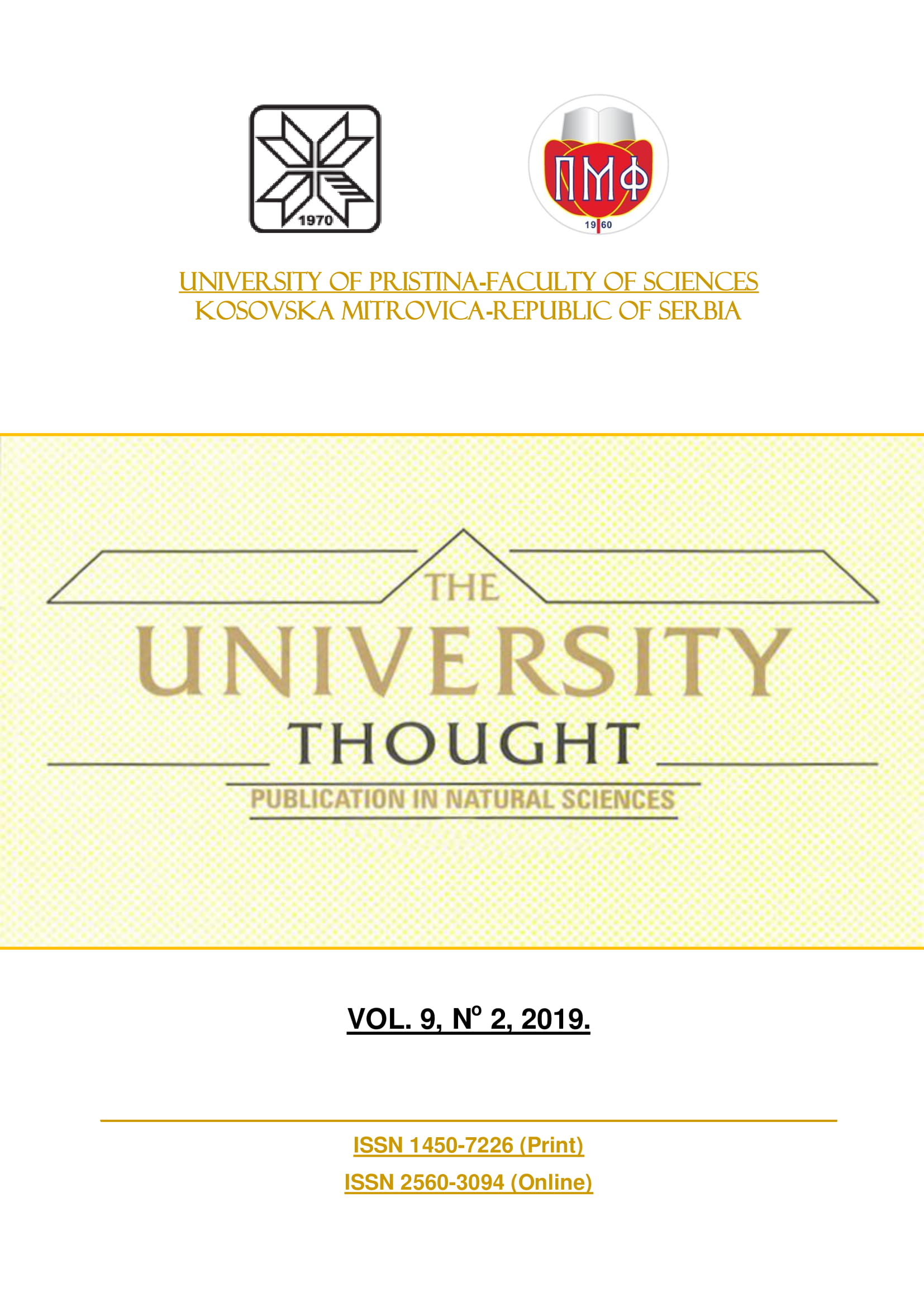GENERALIZATION AND CHARTOMETRIC ANALYSIS OF THE SITNICA RIVER NETWORK SYSTEM
Abstract
The basin of Sitnica river represents a good option for chartometric investigation. In modern hydrology, digital and GIS analyses play very important role today. In this research we were able to obtain the main properties of the river basin and river network with the help of digital line generalization. The results from the two kind of maps with two scales 1:25.000 and 1:50.000 showed differences in length of the main river Sitnica and its tributaries. These differences may be included into the analysis of the Sitnica river network. For the first time it was concluded that the Sitnica river has bi-polar dendritic parallel network. The 80% of right tributaries have angles between 2° and 5° degrees in direction of the Sitnica river. The left tributaries have angles between 1° and 2° degrees with the main water-course.
References
Abrams, M. 2000. The Advanced Spaceborne Thermal Emission and Reflection Radiometer (ASTER): Data products for the high spatial resolution imager on NASA's Terra platform. International Journal of Remote Sensing, 21(5), pp. 847-859. doi:10.1080/014311600210326
Arnheim, R. 1976. The Perception of Maps. The American Cartographer, 3(1), pp. 5-10. doi:10.1559/152304076784080276
Bertin, J. 1983. Semiology of Graphics: Diagrams, Networks, Maps. University of Wisconsin Press.
Brunner, F. 1997. Continuous Monitoring of Deformations using the Global Positioning System. AvH-Magazine, 69.
Court, A. 1966. The Inter-Neighbor Interval. Yearbook of the Association of Pacific Coast Geographers, 28(1), pp. 180-182. doi:10.1353/pcg.1966.0005
Douglas, D., & Peucker, T. 1973. Algorithms for the Reduction of the Number of Points Required to Represent a Digitized Line or its Caricature. Canadian Cartography, 10, pp. 111-122.
Harrie, L., & Weibel, R. 2007. Modelling the Overall Process of Generalisation. In W. A. Mackaness, A. Ruas, & L. T. Sarjakoski Eds., Generalisation of Geographic Information.Elsevier BV., pp. 67-87. doi:10.1016/b978-008045374-3/50006-5
Ivanović, R., Valjarević, A., Vukoičić, D., & Radovanović, D. 2016. Climatic regions of Kosovo and Metohija. The University Thought - Publication in Natural Sciences, 6(1), pp. 49-54. doi:10.5937/univtho6-10409
Jun, C., Ban, Y., & Li, S. 2014. China: Open access to Earth land-cover map. Nature, 514(7523), pp. 434-434. doi:10.1038/514434c
Kraak, M. J., & Ormeling, F. J. 1996. Cartography: Visualization of spatial data. London: Longman.
Labus, D. 1974. Hydrological regions in Kosovo. In Collecting paper of the University of Pristina. Pristina. pp. 123-140.
Lukić, T., Marković, S. B., Stevens, T., Vasiljević, D. A., Machalett, B., Milojković, N., Basarin, B., & Obreht, I. 2009. The Loess “Cave” Near the Village of Surduk: An Unusual Pseudokarst Landform in the Loess of Vojvodina, Serbia. Acta Carsologica, 38(2-3). doi:10.3986/ac.v38i2-3.124
Mackaness, W., & Edwards, G. 2002. The Importance of The Modelling Pattern and Structure in Automated Map Generalization. In Proceeding of the Joint Workshop on Multi-Scale Representations of Spatial Data. Ottawa. pp. 1243-1249.
Milanović, M., Tomić, M., Perović, V., Radovanović, M., Mukherjee, S., Jakšić, D., Petrović, M., & Radovanović, A. 2017. Land degradation analysis of mine-impacted zone of Kolubara in Serbia. Environmental Earth Sciences, 76(16). doi:10.1007/s12665-017-6896-y
Petere, B. 2001. Measure for the Generalization of Polygonal Maps with Categorical Data. In Fourth ICA Workshop on Progress in Automated Map Generalization, Bejing.
Robinson, H. A. 1995. Elements of Cartography.New York: John Wiley and Sons, Inc.
Schneider, U., Becker, A., Finger, P., Meyer-Christoffer, A., Ziese, M., & Rudolf, B. 2014. GPCC's new land surface precipitation climatology based on quality-controlled in situ data and its role in quantifying the global water cycle. Theoretical and Applied Climatology, 115(1-2), pp. 15-40. doi:10.1007/s00704-013-0860-x
Szyperski, C., & Murer, D. 2002. Component Software.Addison Waslay. pp. 123-129; 2nd Edition.
Topfer, F., & Pilliwizer, W. 1996. The Principles of Selections. Cartography Journal, 3, pp. 10-16.
Valjarević, A., Živković, D., & Stevanović, V. 2013. Comparison of an analogue and computer supported line generalisation following the concrete example of the Sitnica River system. Scientific Research and Essays, 8(34), pp. 637-1648. doi:10.5897/sre11.1804
Valjarević, A., Srećković-Batoćanin, D., Valjarević, D., & Matović, V. 2018a. A GIS-based method for analysis of a better utilization of thermal-mineral springs in the municipality of Kursumlija (Serbia). Renewable and Sustainable Energy Reviews, 92, pp. 948-957. doi:10.1016/j.rser.2018.05.005
Valjarević, A., Djekić, T., Stevanović, V., Ivanović, R., & Jandziković, B. 2018b. GIS numerical and remote sensing analyses of forest changes in the Toplica region for the period of 1953–2013. Applied Geography, 92, pp. 131-139. doi:10.1016/j.apgeog.2018.01.016
Valjarević, A., & Živković, D. 2018c. Digital topographic modelling in case with higher flood in the municipality Obrenovac. The University Thought - Publication in Natural Sciences, 8(2), pp. 44-48. doi:10.5937/univtho8-18679
Wu, S., & Chen, Y. 2016. Examining eco-environmental changes at major recreational sites in Kenting National Park in Taiwan by integrating SPOT satellite images and NDVI. Tourism Management, 57, pp. 23-36. doi:10.1016/j.tourman.2016.05.006
Authors retain copyright and grant the journal right of first publication with the work simultaneously licensed under a Creative Commons Attribution License that allows others to share the work with an acknowledgement of the work's authorship and initial publication in this journal.

